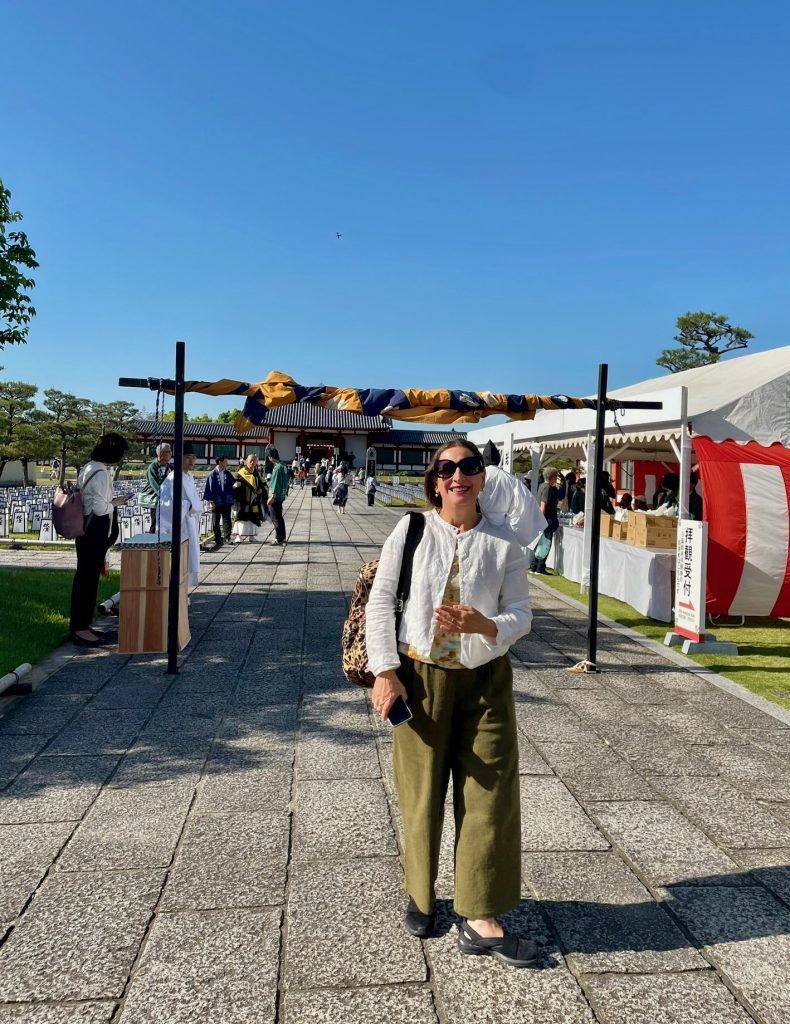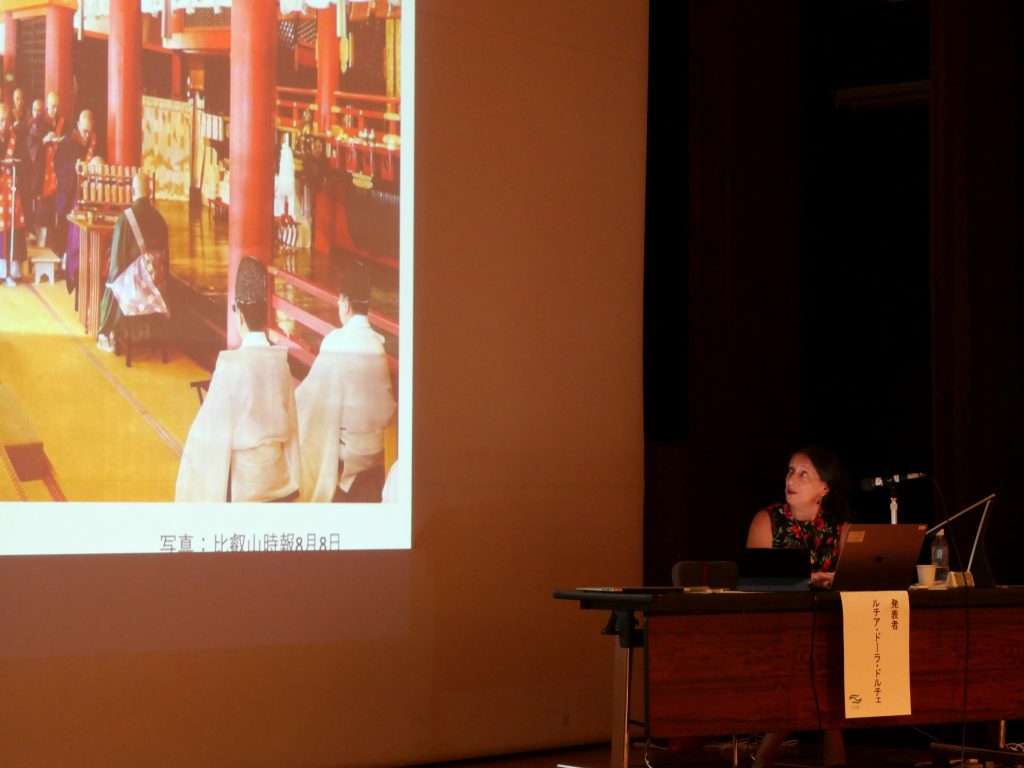Buddhist Texts and Fieldwork: A Woman’s Journey in the Study of Japanese Religions
Lucia Dora Dolce (Numata Professor of Japanese Buddhism at SOAS University of London) was a visiting research scholar at Nichibunken from April 2024 to March 2025 to conduct research on “Monks and Embryos: The construction of the ritual body in mediaeval Japan.” She holds a first degree in Japanese Studies from the University of Venice, and received her PhD from Leiden University.

What sparked your interest in Japan, and how did you get into studying Japanese religions?
Since this was a long time ago and it is a question I am always asked, I think it has become a bit of a myth, and I’m not sure how much of it is true anymore! When I was in secondary school, I was interested in philosophy. I studied Western philosophy and wanted to know how the other side of the world was thinking. I had always been fascinated by images of Japan in the illustrated encyclopedias that kids used to read.
The summer before I enrolled at university, I by chance met a friend of a friend who was studying Japanese in Venice, and she told me there was a new professor of religions and philosophy there. Studying philosophy and Japanese language seemed like a perfect combination to me. Eventually, I found out that this professor, who later became my supervisor, was an anthropologist rather than a philosopher. I was interested in the concept of time in Zen philosophy, but went on to write my MA thesis on millenarian ideas (mappō shisō), focusing on Nichiren, a 13th-century monk who wrote explicitly about this idea. Yes, I think the openness and methodological awareness in disciplines such as anthropology opened up a variety of ways of studying for me. I ended up focusing on medieval material, but I have kept an interest in contemporary practices, and I still do a lot of fieldwork when I am in Japan.
How did you go about learning Classical Japanese, and what difficulties have you faced with the language?
I didn’t receive formal training in Venice, but in Leiden I participated in reading classes focused on Classical Japanese, and I took kanbun classes when I came to Japan as a non-degree student and later as a PhD student. For me, the challenge was that all of Buddhist literature is written in Chinese, but since I learned to read primary sources mainly in Japan, I read it in kanbun. But Japanese is a complex language. I can read very complicated Buddhist texts, but I struggle with reading articles on finance, for example.
Language education opens up many ways of thinking because you continuously have to ask yourself what things mean in order to translate them accurately. This is something that Japanese speakers do not necessarily do when they read Chinese, for instance. Since Chinese and Japanese are both visual languages, Japanese people don’t need to ask what the exact meaning of a passage from the Chinese Buddhist canon is because they can “see” it with their eyes (at least at a superficial level). I think as “foreigners,” we have a role in clarifying things, especially with the choice of words. In the context of Buddhism, you can have completely different discussions depending on the words you choose. There is also a multilayered meaning in Chinese characters, which becomes especially tricky when discussing topics like religion and philosophy.
What are the challenges of being accepted as a European scholar of Buddhism in Japan?
Japan has been a great producer of knowledge on Buddhism, but Japanese Buddhism remains a very limited field in Europe, which is not always in conversation with research on other Buddhisms or, indeed, other disciplinary fields. I think it is important to produce new research that shifts received perspectives in a language that does not alienate Japanese scholars. In my research, I have put forward at times unconventional or controversial interpretations, but I have always wanted to be sure that they were possible interpretations. It used to be very difficult to be accepted as a non-Japanese researcher in Japan, but I feel that Japanese scholars of my generation are more open to Western scholars contributing valuable insights. I think my research has been well received, judging from the invitations I receive to speak in Japan, and from the very fact that my work is referred to by Japanese scholars. I’m very happy about this, especially because I am a woman. Being a female researcher in a predominantly male world has had its own challenges. Buddhist studies has been particularly slow in opening up to women.

What are the challenges you face in teaching?
I have taught in different programs, and the challenges are different depending on the program. For instance, currently I teach a class on Japanese Buddhist thought within a World Philosophy program, and the class is taken by students studying for various different degrees. One major issue is that we scholars haven’t produced enough English materials for students. Existing textbooks are limited, compared to the range of topics we teach. Students who do not know Japanese want more conceptual articulations, rather than historical accounts which have characterized introductions to Japanese Buddhist thought. Unfortunately, we scholars tend to write in a way that is too technical, and directed more at our peers more than our students. A few years ago, I wrote an article for The SAGE Handbook of Modern Japanese Studies titled “The Practice of Religion in Japan: An Exploration of the State of the Field” with my MA students in mind. For many years, it was the most downloaded article from my academia page. Sources like this—general in scope but underpinned by in-depth research—should perhaps be encouraged now that research has been more narrowly defined. Opening up a traditional subject to a student body that lacks enough background knowledge of Japan is a significant challenge.
What are your thoughts on globalizing Japanese studies and what is your message for PhD students?
Japanese studies is no longer in its first stage, and I think we need to revive the study of Japan. In Buddhist studies, China has taken a lot of space recently, which is a positive development, but we need to bring Japan back into focus. Japan is an enormous repository of knowledge, not only secondary knowledge but also of materials that are very important for our field. The challenge, however, is that Japanese scholars in Buddhist studies often speak only Japanese. When they do speak English at international conferences, they basically speak according to Japanese modes to a public made of colleagues who speak Japanese as well. So, there is perhaps a need to think more about how Japanese knowledge can be conveyed to a wider audience. Interdisciplinarity is another important point that is not sufficiently acknowledged. There needs to be more openness to different methodologies for approaching Buddhist studies.
Scholars should make an effort to present their research according to the norms of the place they are presenting in, rather than simply conforming to their own ways. For example, making a clear argument is essential when presenting in English. These methodological questions are very important for globalizing Japanese studies. Another issue is that Japanese PhD students are going abroad less and less, which is certainly a problem. While the sources are available here in Japan, going abroad offers the opportunity to look at the same material from different perspectives. Similarly, it is essential that Western PhD students spend significant time in Japan and participate in Japanese seminars to understand how knowledge has been transmitted here. I envision a much closer exchange, one that acknowledges each other’s differences in methodology and focus, and recognizes the benefits of multiple approaches.


